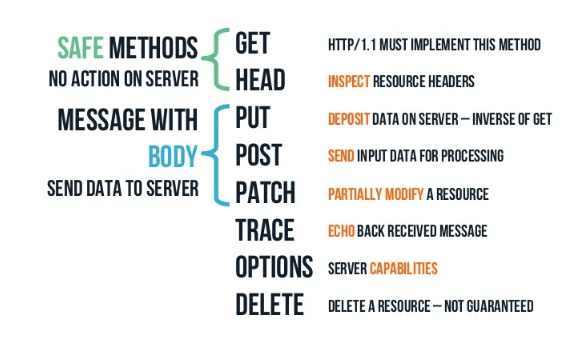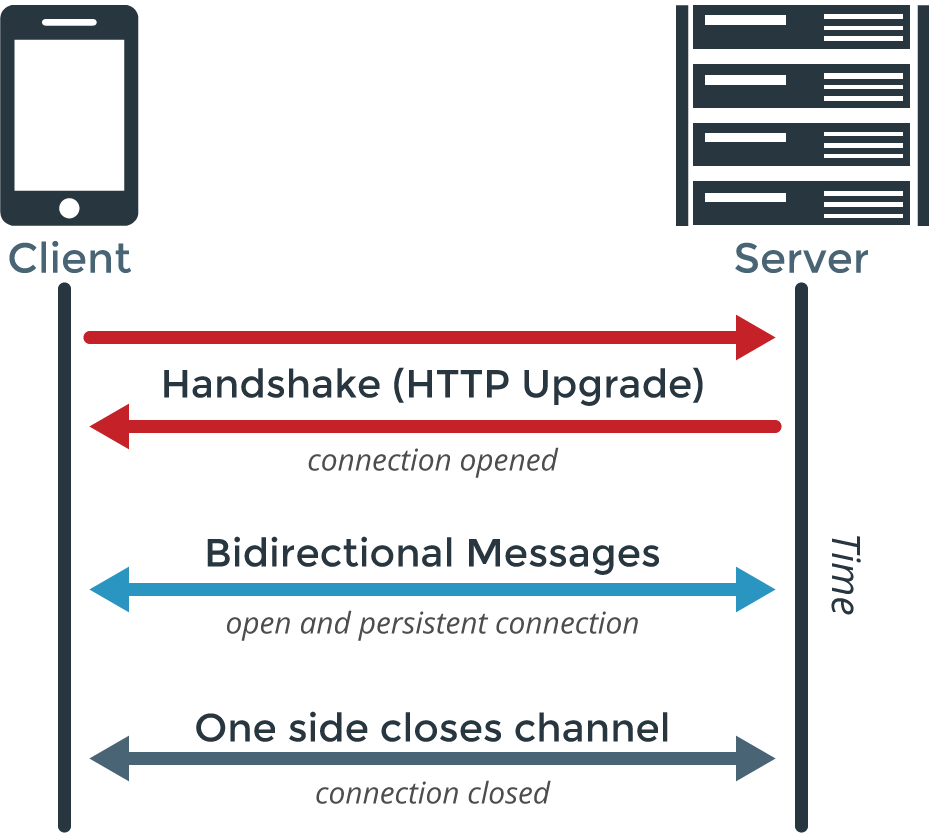
- Introduction to HTTP
- What are HTTP Request Methods?
- HEAD and OPTIONS Methods
- Idempotent Methods
- Safe Methods
- Real-World Examples
- Best Practices for API Requests
- Conclusion
HTTP request methods, also known as HTTP verbs, define the specific actions a client wants to perform on a resource in a web application. These methods are fundamental to the functioning of RESTful APIs and client-server communication. The most commonly used HTTP methods include GET request (to retrieve data), POST (to create resources), PUT (to update or replace resources), DELETE (to remove resources), and PATCH (to partially update resources). Additionally, Web Designing and Development Courses is used to fetch headers without the response body, and OPTIONS provides information about the communication options supported by the server. Each method is associated with properties such as safety (whether it changes data), idempotency (whether multiple identical requests have the same effect), and cacheability. Understanding these methods is crucial for designing secure, efficient, and well-structured web services, ensuring clear and consistent interactions between clients and servers.
Introduction to HTTP
HTTP request methods, also known as HTTP verbs, define the specific actions a client wants to perform on a resource in a web application. These methods are fundamental to the functioning of RESTful APIs and client-server communication. The most commonly used HTTP methods include GET request (to retrieve data), POST (to create resources), PUT (to update or replace resources), DELETE (to remove resources), and PATCH (to partially update resources). Additionally, HEAD is used to fetch Angularjs vs Jquery without the response body, and OPTIONS provides information about the communication options supported by the server. Each method is associated with properties such as safety (whether it changes data), idempotency (whether multiple identical requests have the same effect), and cacheability. Understanding these methods is crucial for designing secure, efficient, and well-structured web services, ensuring clear and consistent interactions between clients and servers.
Master Web Development skills by enrolling in this Web Developer Certification Courses today.
What are HTTP Request Methods?
HTTP methods define the type of action to be performed on a given resource. These methods, known as HTTP verbs, are React Native and Barcode to how RESTful APIs and web services function. The most commonly used HTTP methods are:
- GET: Retrieves data from the server without modifying it.
- POST: Sends data to the server to create a new resource.
- PUT: Updates or replaces an existing resource on the server.
- DELETE: Removes a specified resource from the server.
- PATCH: Partially updates a resource with new data.
- HEAD: Similar to GET, but only returns headers (no body).
- OPTIONS: Describes the communication options available for a resource.

Each method serves a specific purpose and is associated with different levels of safety, idempotency, and intended operation: Safe methods (like GET request and HEAD) do not modify resources. Idempotent methods (like GET, PUT, DELETE) produce the same result no matter how many times they are called. POST and PATCH are non-idempotent and typically used for creating or partially updating data. Choosing the correct method is React JS Developer Roadmap for efficient, secure, and predictable communication between clients and servers. Proper usage also ensures scalability and adherence to REST principles in modern web application development.
Enhance your knowledge in Web Development . Join this Web Developer Certification Courses now.
Idempotent Methods
Idempotency means that making the same request multiple times has the same effect as making it once. The following methods are considered idempotent:
- GET
- PUT
- DELETE
- HEAD
- OPTIONS
This property is essential for ensuring reliability in web applications, especially when handling network failures or retries. Developers design APIs to be idempotent to avoid side effects from duplicate requests. Idempotency ensures that performing the same operation multiple times has the same effect as performing it once. For example, making multiple PUT requests to update a user’s profile with the same data will not cause unintended changes. Web Developer Certification Courses is particularly important in payment systems, where duplicate transactions could result in financial loss. By using idempotent methods like PUT and DELETE, APIs become more predictable and fault-tolerant. It also simplifies client-side logic, as developers can safely retry requests without fear of altering data incorrectly. Overall, idempotency contributes significantly to the robustness and reliability of RESTful services.
Safe Methods
Safe methods do not alter the state of the server. They are used strictly for retrieving data without side effects. The safe HTTP methods include:
- GET
- HEAD
- OPTIONS
- The HEAD and OPTIONS methods are two HTTP request methods used primarily for obtaining metadata and information about a web resource without actually retrieving the resource itself.
- The HEAD method is similar to a GET request, but it does not return the body of the response—only the headers. JavaScript Callback Functions is typically used when a client wants to check characteristics of a resource, such as its size, type, or last modified date, without downloading the entire content. This is useful for performance optimization and verifying whether a resource has changed, such as in caching scenarios.
- The OPTIONS method, on the other hand, is used to describe the communication options available for a particular URL or server. It allows the client to determine which HTTP methods (e.g., GET, POST, PUT, DELETE) are supported by the server for a specific resource
- This is particularly important in CORS (Cross-Origin Resource Sharing) situations, where a browser might use an OPTIONS request (a preflight request) to check permissions before making the actual request.
- Both methods are vital for enabling efficient and secure communication in web applications, especially in RESTful API design and web security contexts. Additionally, they help developers build lightweight and responsive client-side applications.
- HEAD requests can save bandwidth by avoiding unnecessary content downloads. OPTIONS requests also provide essential information for debugging and API documentation. Together, they contribute to better performance, scalability, and user experience in modern web systems.
- Web Browsing: Clicking on a link uses a GET request to fetch a new page.
- Login Forms: Submitting a login form uses a POST request with Downloading Node.js and NPM.
- Updating User Info: To edit a user profile, you can use PUT or PATCH, depending on whether it’s a full or partial update.
- Deleting Posts: Removing a blog post uses a DELETE request.
- AJAX Applications: JavaScript often uses GET and POST via XMLHttpRequest or Fetch API to interact with servers without reloading the page.
Using safe methods helps improve application security, allows HTTP Request Methods, and enables better prediction of Hypertext Transfer Protocol request outcomes. It’s a key principle in RESTful API design.
Advance your Web Development career by joining this Web Developer Certification Courses now.
HEAD and OPTIONS Methods

Real-World Examples
Preparing for Web Development interviews? Visit our blog for the best Web Development Interview Questions and Answers!
Best Practices for API Requests
Use the Correct HTTP Method Ensure your API uses methods semantically. Follow RESTful Principles Structure URLs around resources, not actions. Implement Authentication Secure your API using tokens or sessions. Use Status Codes Return appropriate Hypertext Transfer Protocol status DevOps vs Full Stack to indicate success, failure, or redirection. Validate Input Always validate client input to avoid security issues. Enable Caching For GET requests, use cache headers to improve performance. Avoid Overloading POST Don’t use POST for updates or deletions. Rate Limiting Prevent abuse by limiting the number of requests per user/IP. Log Requests and Responses Useful for debugging and analytics. Support CORS Allow cross-origin requests securely using proper headers.
Conclusion
HTTP request methods are the foundation of communication between clients and servers on the web. Each method as GET, POST, PUT, DELETE, HEAD, OPTIONS, and others has a specific purpose and defines the intent of the client’s request. Understanding these methods is essential for designing secure, efficient, and RESTful web applications. By using the appropriate method for each operation, developers can create APIs that are more predictable, scalable, and aligned with web standards. In Web Designing Training , mastering HTTP methods is crucial for anyone involved in web development or API design, as it ensures better performance, security, and interoperability across systems.




